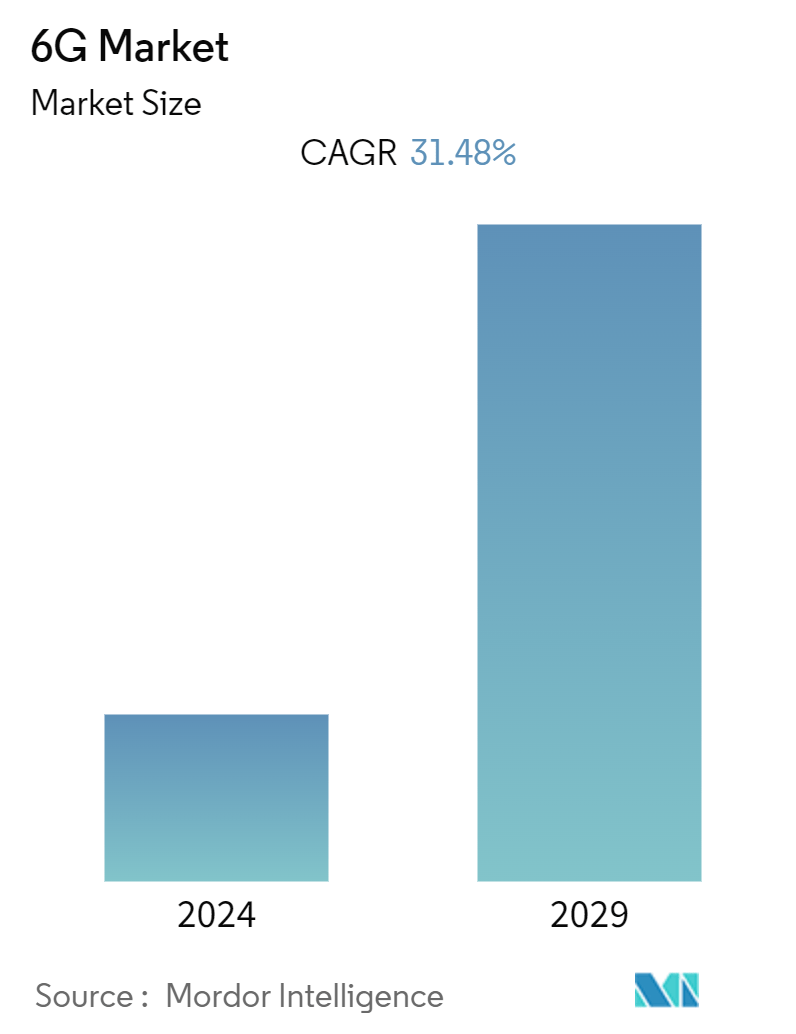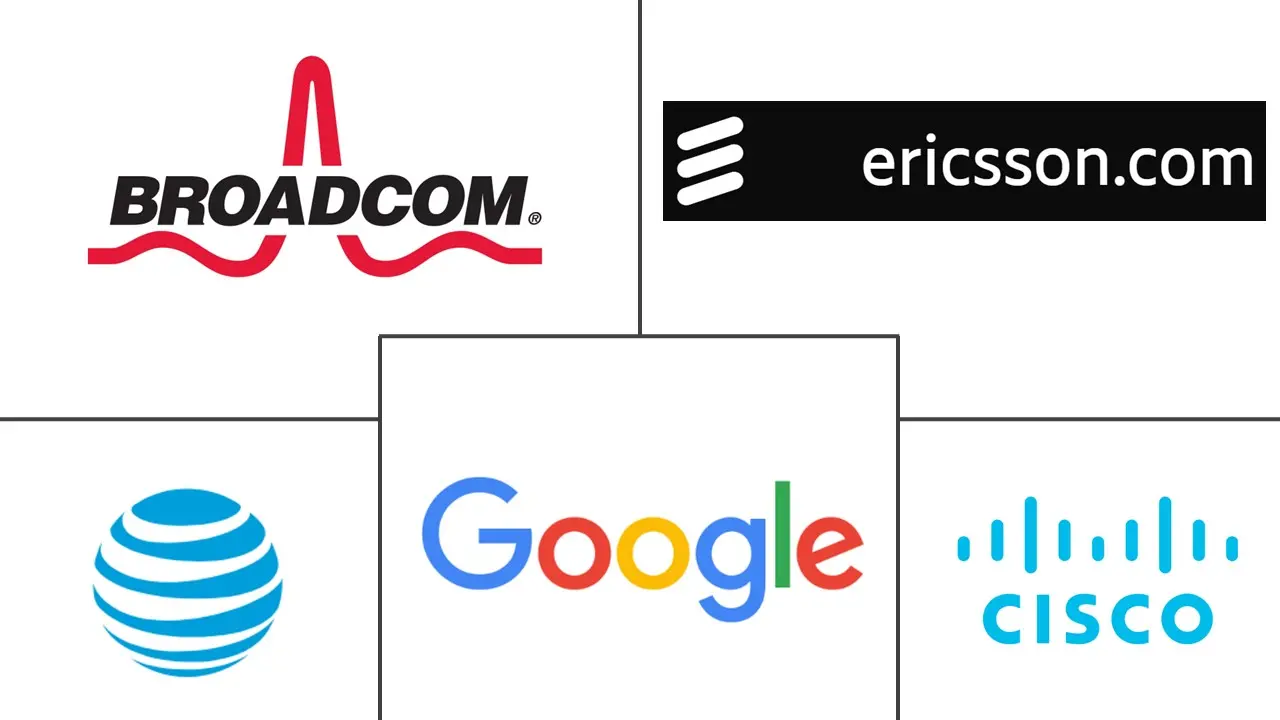Market Size of 6G Industry

| Study Period | 2019 - 2029 |
| Base Year For Estimation | 2023 |
| CAGR (2024 - 2029) | 31.48 % |
| Fastest Growing Market | Asia Pacific |
| Largest Market | North America |
| Market Concentration | High |
Major Players
*Disclaimer: Major Players sorted in no particular order |
6G Market Analysis
The 6G Market is expected to register a CAGR of 31.48% during the forecast period.
- 6G is anticipated to become available in the 2030s, building on societal, consumer, and industry use-case mobile connectivity breakthroughs enabled by the high-end capabilities of 5G. It is expected that 6G will contribute to a more innovative, more sustainable, and more efficient society with new uses for multisensory extended realities, precision health care, smart agricultural cobot, and intelligent autonomous systems by merging the digital and physical worlds.
- The increasing emphasis on connectivity and demand for 6G communication in newly developing technologies, e.g., the Internet of Things or cryptocurrencies, are significant factors contributing to the industry's growth. The introduction of high-speed Internet and remote connectivity, which are fundamental to the characteristics of 6G technologies, will be conducive to commercializing such communication technologies.
- Rapid urbanization and communication, now a fundamental right for human nutrition, will also play an essential role in shaping the market. A large population has already moved to the big cities for increased opportunities and better living. The critical role of communication and connectivity in this transition has been played. Moreover, the adoption of 6G technology will be significantly influenced by growing efforts toward supporting smarter cities and population growth in urban areas.
- In order to ensure the reliability of Internet of Things devices and networks, 6G will likely draw on the original success of 5G. Moreover, the emergence of 6G will coincide with a much larger level of automation and intelligent devices, such as warehouse robots at production sites, in view of its lower latency and higher data load compared to 5G.
- Further, to enable the development of 5G ecosystems and to support 6G research in Europe, the Smart Networks and Services Joint Undertaking selected its first portfolio of 35 R&I and trial projects. The objective is to create a first-class European supply chain in the field of advanced 5G systems as well as build Europe's capacity for 6G technology. These investments are significantly driving the market growth rate.
6G Industry Segmentation
6G is the sixth-generation technology standard for cellular networks currently under development for wireless communications technologies supporting cellular data networks. It is the planned successor to 5G and will likely be significantly faster. Like its predecessors, 6G networks will probably be broadband cellular networks, in which the service area is divided into small geographical areas called cells
The 6g market is segmented by devices (mobile devices, IoT and edge computing devices, and other devices), by end-user vertical (agriculture, automotive, healthcare, government, manufacturing, and other end-user verticals), and by region (North America, Europe, Asia-Pacific and the Rest of the World). The market sizes and forecasts are provided in terms of value (USD) for all the above segments.
| By Devices | |
| Mobile Devices | |
| IoT and Edge Computing Devices | |
| Other Devices |
| By End-user Vertical | |
| Agriculture | |
| Automotive | |
| Healthcare | |
| Government | |
| Manufacturing | |
| Other End-user Verticals |
| By Geography*** | |
| North America | |
| Europe | |
| Asia | |
| Australia and New Zealand | |
| Latin America | |
| Middle East and Africa |
6G Market Size Summary
The 6G market is on the cusp of transformative growth, driven by the increasing demand for advanced connectivity solutions and the integration of digital and physical worlds. As industries and societies evolve, 6G is expected to play a pivotal role in enhancing multisensory extended realities, precision healthcare, smart agriculture, and intelligent autonomous systems. The technology's high-speed internet and remote connectivity features are crucial for commercializing new communication technologies, particularly in urban areas experiencing rapid population growth. The market's expansion is further fueled by the burgeoning Internet of Things (IoT) sector, which necessitates robust infrastructure to support the anticipated surge in data traffic and mobile connectivity. Investments in research and development, particularly in Europe and North America, are laying the groundwork for a strong 6G ecosystem, with significant contributions from major telecom players and government initiatives.
In North America, the United States stands out as a leader in 6G innovation and investment, with substantial funding directed towards building advanced wireless networks. The U.S. government's initiatives, such as the public wireless supply chain innovation fund, aim to enhance security and competitiveness in the global supply chain. Collaborative efforts among major industry players, including strategic partnerships and joint ventures, are accelerating the development of 6G technologies. These collaborations are essential for sharing resources and advancing research in open and virtualized radio access networks. Globally, countries like France and South Korea are also making significant investments in 6G research and development, underscoring the technology's importance on the world stage. As the market evolves, companies are focusing on cohesive strategies to maintain competitiveness and drive future commercial deployment.
6G Market Size - Table of Contents
-
1. MARKET INSIGHTS
-
1.1 Market Overview
-
1.2 Industry Attractiveness - Porter's Five Forces Analysis
-
1.2.1 Bargaining Power of Buyers
-
1.2.2 Bargaining Power of Suppliers
-
1.2.3 Threat of New Entrants
-
1.2.4 Threat of Substitutes
-
1.2.5 Intensity of Competitive Rivalry
-
-
1.3 Industry Value Chain Analysis
-
1.4 Macro Economic Factors Impacting the market
-
-
2. MARKET SEGMENTATION
-
2.1 By Devices
-
2.1.1 Mobile Devices
-
2.1.2 IoT and Edge Computing Devices
-
2.1.3 Other Devices
-
-
2.2 By End-user Vertical
-
2.2.1 Agriculture
-
2.2.2 Automotive
-
2.2.3 Healthcare
-
2.2.4 Government
-
2.2.5 Manufacturing
-
2.2.6 Other End-user Verticals
-
-
2.3 By Geography***
-
2.3.1 North America
-
2.3.2 Europe
-
2.3.3 Asia
-
2.3.4 Australia and New Zealand
-
2.3.5 Latin America
-
2.3.6 Middle East and Africa
-
-
6G Market Size FAQs
What is the current 6G Market size?
The 6G Market is projected to register a CAGR of 31.48% during the forecast period (2024-2029)
Who are the key players in 6G Market?
AT&T, Broadcom, Cisco, Ericsson and Google are the major companies operating in the 6G Market.

